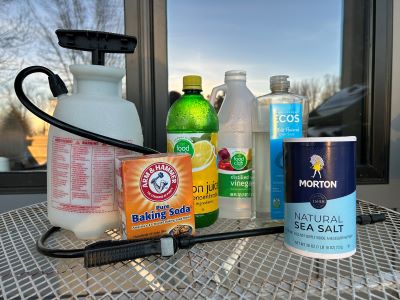To DIY or not to DIY: Why use registered herbicide products?
By Noelle Orloff, Associate Extension Specialist and Schutter Lab Diagnostician
Introduction

Photo; Noelle Orloff, MSU
We regularly answer questions from people interested in using household products to kill unwanted plants or other organisms. Some of these questions stem from “do-it-yourself” herbicide recipes found online. Others are a result of looking in the kitchen cabinet or garage, and wondering what might happen if a given substance were applied to an unwanted organism. The impulse to use household products as herbicides makes sense. They are already on hand; the substances are familiar so may feel somewhat safer than synthetic herbicides; and indeed, people in Montana tend to have a DIY attitude. However, in most cases we recommend using a registered, labelled herbicide product to control weeds.
What is on the label of a registered herbicide?
Registered herbicides are those approved by the US Environmental Protection Agency and corresponding state lead agency for use. They must have certain information included on the label, and this information is helpful for using the product safely and effectively. For example, the label will often include information about which weeds can be controlled using the product, what herbicide rate to use in given situations, and considerations for avoiding non-target injury to desired plants, insects, or vertebrates. Information about how to use the product safely and how to avoid environmental impacts will also be included. This type of information is backed up by research and testing.
Organic pesticide products
Many people try a DIY herbicide because they want to use something they perceive as natural. An alternative is to try a registered herbicide that is certified by OMRI (Organic Materials Review Institute; https://www.omri.org/). There are an increasing number of these products from naturally derived sources available on the market, including at the local hardware store or garden center. These products will have a label, meaning that they have been tested for effectiveness and environmental impact, deliver a consistent product, and include instructions for proper use and safety. As with any herbicide, some OMRI approved products work better than others for certain weeds. For example, see Does Vinegar Kill Weeds? from the Monthly Weed Post archive for an explanation of considerations for using acetic acid as an herbicide.
What is your goal?
It is important to consider the overall reason you are trying to manage weedy plants. Is it simply to kill weeds, or are you also concerned with soil health and the wellbeing of other plants in the landscape? Many different substances from diesel fuel to hydrochloric acid to table salt can injure or kill existing weeds and inhibit future weed growth. However, they may also prevent desirable plants from growing at the application site for years. Not to mention the impacts of such substances on other organisms in the soil, pollinators, pets, or even human health during or after application.
For more information, see the MSU Extension publication Pesticide Labels to learn about what can be found on herbicide product labels.
Further Information
For more information about this month's weed post, contact Associate Extension Specialist Noelle Orloff. Past posts are available in the Monthly Weed Post Directory.
This weed post is also available as a printable PDF (207 KB).
